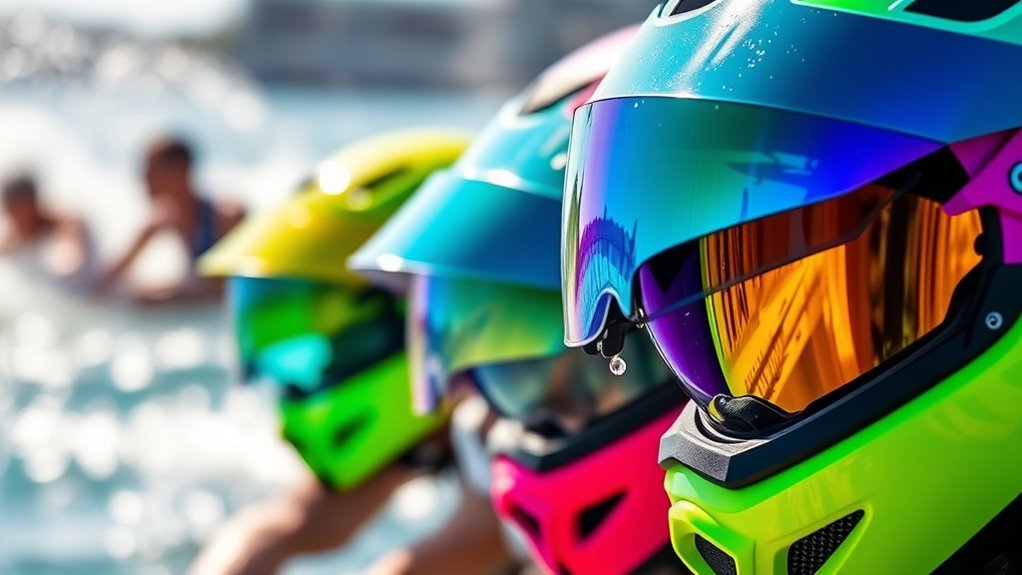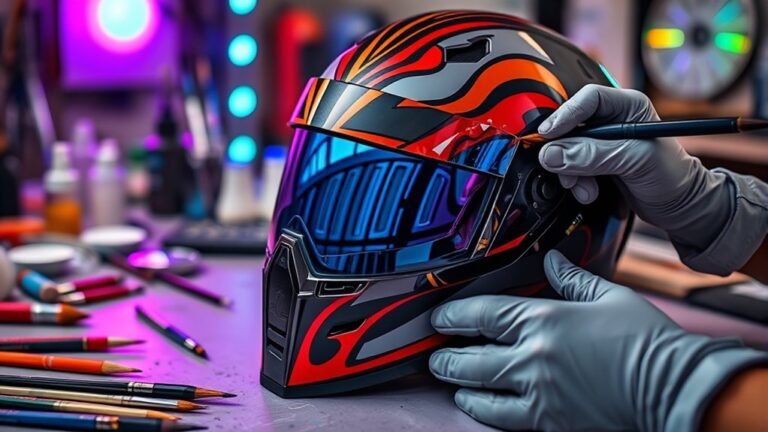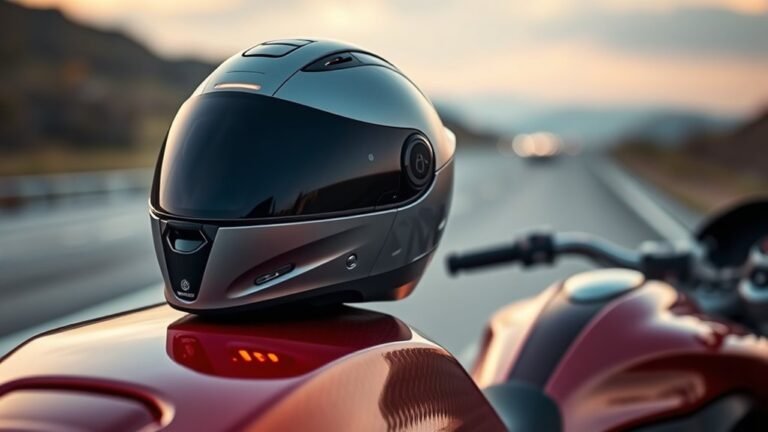Helmet Visor Options for Water Sports
When selecting a helmet visor for water sports, consider tinted visors for sunny conditions to reduce glare, while clear visors are perfect for overcast days. Prioritize UV protection to shield your eyes from harmful rays that enhance reflections off water. Look for anti-fog features and scratch-resistant coatings for best visibility and durability. Make sure the visor fits well with your helmet style. Explore various options available, and you’ll discover even more about choosing the ideal visor.
Understanding the Importance of a Helmet Visor in Water Sports
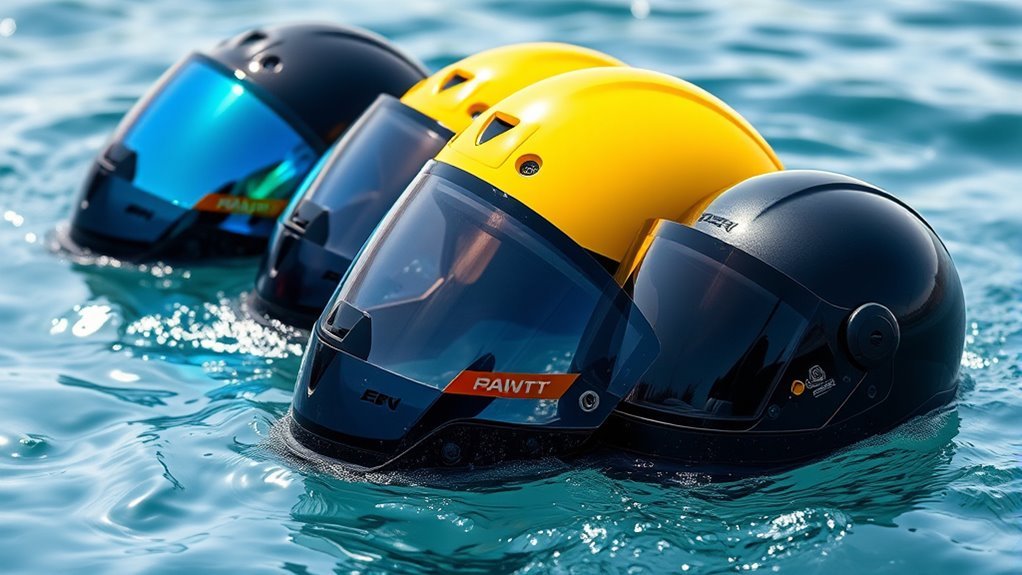
When you’re out on the water, understanding the importance of a helmet visor can be a game-changer for your safety and performance. A visor offers essential benefits, shielding your eyes from harsh sunlight, wind, and water spray, enhancing your visibility and focus. This means you can navigate waves and obstacles with greater precision, boosting your confidence and freedom on the water. In addition, safety enhancements come into play, as a well-designed visor can protect against potential debris and impacts, reducing the risk of injury. With the right visor in place, you’re not just enjoying your sport; you’re actively investing in your wellbeing, ensuring that every ride is as exhilarating as it is secure. So, gear up and ride with confidence!
Types of Visors: Tinted vs. Clear
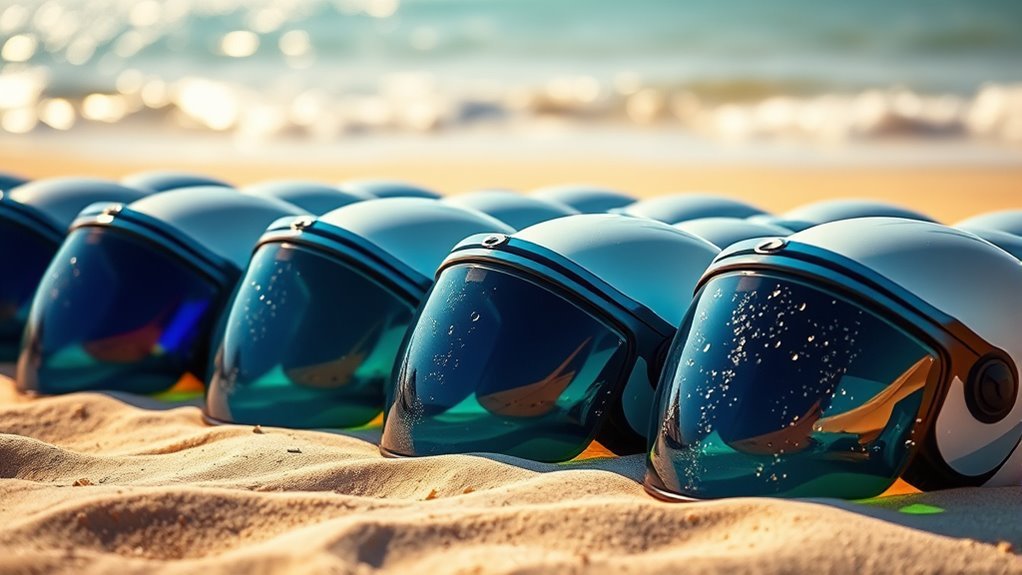
Choosing the right visor can greatly impact your experience on the water, and understanding the differences between tinted and clear options is key. Tinted visors provide significant advantages, particularly in bright sunlight, reducing glare and enhancing visibility. They can help prevent eye strain, allowing you to focus on the ride. However, clear visors come with their own benefits; they’re ideal for low-light conditions or overcast days, ensuring you won’t miss any details in your surroundings. If you’re chasing freedom on the water, consider the environment and your activities. Whether you opt for tinted or clear, each visor type serves a purpose, so choose one that complements your adventure for ultimate enjoyment.
UV Protection: Why It Matters

While enjoying water sports, you might not realize just how crucial UV protection is for your eyes. Prolonged UV exposure can lead to serious health risks, including cataracts and macular degeneration. Your helmet visor isn’t just about style; it’s a critical line of defense against harmful rays. By choosing a visor with adequate UV protection, you’re safeguarding not only your eyes but also your skin. Sunlight reflects off water, intensifying UV radiation, which increases the risk of skin damage and long-term effects like premature aging. Don’t overlook this essential aspect of your gear. Investing in quality visors that offer proper UV protection means you can embrace the freedom of water sports while prioritizing your health. Enjoy the waves, but protect yourself!
Anti-Fog Features for Optimal Visibility
When you’re out on the water, foggy visors can seriously impair your visibility. Understanding the latest coating technologies and effective ventilation systems can help you choose a helmet visor that keeps your view clear. Let’s explore how these features work together to enhance your safety and enjoyment while participating in water sports.
Coating Technologies Explained
Although fogging can be a significant issue during water sports, modern coating technologies have made it easier than ever to maintain peak visibility. With advancements in materials, you can choose visors that enhance your experience on the water. Here are four key features to take into account:
- Hydrophobic Coatings – These repel water, preventing droplets from forming and obstructing your view.
- Anti-Fog Treatments – Specially designed to minimize condensation, keeping your visor clear.
- Photochromic Technology – Automatically adjusts tint based on light conditions, ensuring ideal visibility in varying environments.
- Scratch-Resistant Finishes – Protects your visor from abrasions while maintaining clarity.
These technologies can transform your helmet visor, allowing you to focus on the thrill of the ride without worrying about visibility.
Ventilation Systems Overview
To enhance visibility during water sports, effective ventilation systems are essential in combating fogging issues that can arise in helmet visors. A well-thought-out ventilation design boosts airflow efficiency, allowing moisture to escape while keeping your view clear. Here’s a quick comparison of different ventilation systems available:
| System Type | Airflow Efficiency | Fog Resistance |
|---|---|---|
| Passive Vents | Moderate | Low |
| Active Fans | High | High |
| Adjustable Vents | Variable | Medium |
| Channel Systems | High | High |
| Hybrid Systems | Very High | Very High |
Choosing the right system tailored to your needs will guarantee you enjoy the freedom of water sports without the distraction of fogged visors. Stay focused and ride free!
The Benefits of Anti-Scratch Coatings
While enjoying water sports, the last thing you want is a scratched visor that obscures your vision. That’s where anti-scratch coatings come in, offering significant advantages for your helmet visor. Here are some key anti-scratch benefits:
- Improved Visibility: A clear visor enhances your experience, ensuring you can see the waves and obstacles ahead.
- Coating Durability: These coatings withstand harsh conditions, prolonging the life of your visor.
- Less Maintenance: With fewer scratches, cleaning becomes easier and less frequent, providing you with more time on the water.
- Cost-Effective: Investing in a visor with an anti-scratch coating can save you money in the long run by reducing the need for replacements.
Embrace freedom on the water without worrying about your gear!
Ventilation and Airflow in Helmet Visors
When you’re out on the water, effective ventilation and airflow in helmet visors are essential for maintaining comfort and clarity. Utilizing advanced ventilation mechanisms can greatly enhance your experience by preventing fogging and overheating. Look for visors designed with strategically placed vents that promote airflow dynamics, ensuring fresh air circulates while stale air escapes. This not only keeps your vision clear but also allows you to focus on the thrill of your activity without distractions. Some visors feature adjustable vents, giving you control over airflow based on conditions. By prioritizing helmets with these ventilation features, you can enjoy the freedom of movement and clarity you need to fully immerse yourself in your water sports adventures.
Compatibility With Different Helmet Styles
Choosing a visor that complements your helmet style is key to maximizing both performance and safety in water sports. Understanding visor compatibility with various helmet styles can enhance your experience. Here are four essential points to take into account:
- Shape Match: Verify the visor’s curvature aligns with your helmet’s design for ideal fit.
- Attachment Mechanism: Check how the visor attaches; some helmets use clips, while others may have integrated slots.
- Material Compatibility: Different materials can affect durability and visibility; choose a visor that matches your helmet’s construction.
- Aerodynamics: Select a visor designed for your helmet style to reduce drag and improve performance in the water.
Choosing the Right Size and Fit
Finding the right size and fit for your visor is essential, as it directly impacts both comfort and safety during water sports. A visor that’s too loose can shift unexpectedly, obstructing your view, while one that’s too tight can cause discomfort and distractions. To achieve personal comfort, verify your visor aligns well with your helmet and sits snugly without pinching. Most visors come with fit adjustments, allowing you to customize the fit to your head shape and helmet style. When trying on a visor, move your head around to check for stability. Remember, a well-fitted visor not only enhances your experience but also boosts your confidence as you embrace the thrill of the water. Enjoy your freedom with the perfect visor!
Maintaining and Cleaning Your Visor
Keeping your visor in top condition is essential for ideal visibility and safety during water sports. You’ll want to use proper cleaning techniques to avoid scratches and damage, ensuring your visor remains clear and functional. By following a few simple maintenance steps, you can extend the life of your visor and enhance your overall experience on the water.
Proper Cleaning Techniques
Although you might not think about it often, maintaining your helmet visor is essential for ideal visibility and safety during water sports. Regular cleaning keeps your visor in top shape, ensuring you can enjoy your adventures without distractions. Here are some maintenance tips:
- Use gentle cleaning solutions: Opt for a mild soap mixed with warm water to prevent damage.
- Soft cloth application: Use a microfiber cloth to wipe your visor, avoiding scratches.
- Rinse thoroughly: After cleaning, rinse with fresh water to remove any soap residue.
- Dry properly: Allow your visor to air dry completely before storing it, ensuring no moisture leads to mold or haze.
With these techniques, you’ll keep your visor clear and ready for your next thrill!
Preventing Scratches and Damage
Maintaining a clear visor is only part of the equation when it comes to ensuring your helmet stands the test of time. To enhance your visor’s longevity, consider investing in scratch-resistant options. These visors are designed to withstand the rigors of water sports, protecting against abrasions and ensuring clarity during your adventures. When not in use, store your helmet in a protective bag to shield it from potential impacts or harsh elements. Regularly inspect for scratches and clean gently with a microfiber cloth to prevent further damage. Avoid using harsh chemicals, as they can compromise the visor’s integrity. By taking these steps, you’ll maintain both the function and aesthetics of your visor, allowing you to ride with freedom and confidence.
Tips for Selecting the Best Visor for Your Sport
When you’re selecting the best visor for your water sport, it’s important to take into account factors like material, UV protection, and visibility. Here are some tips to guide your choice:
- Visor Material Options: Choose durable materials like polycarbonate or acrylic for enhanced impact resistance.
- UV Protection: Opt for visors with UV-blocking features to shield your eyes from harmful rays.
- Visor Color Choices: Consider tinted visors for bright conditions; they can reduce glare and enhance contrast.
- Visibility: Make sure the visor provides a clear view without distortion, especially at high speeds.
Frequently Asked Questions
Can I Use a Motorcycle Helmet Visor for Water Sports?
They say, “better safe than sorry.” You shouldn’t use a motorcycle helmet visor for water sports, as it may not meet specific safety standards for water activities. Motorcycle visors are often made from materials that aren’t designed to withstand water impact or UV exposure. For ideal safety and performance, it’s best to choose visors specifically engineered for water sports, ensuring you enjoy your freedom on the water without compromising your safety.
How Do I Know if My Visor Is Properly Fitted?
To guarantee your visor’s properly fitted, check for gaps between the visor and the helmet. It shouldn’t move excessively or allow water or debris to penetrate. You can test the fit by gently pulling the visor; it should stay in place without any resistance. Proper visor fitting is essential for helmet safety, as a loose visor can compromise protection. Always guarantee your gear provides a tight, secure fit for your adventures.
Are There Visors Specifically Designed for Night Water Sports?
Yes, there are visors specifically designed for night water sports, enhancing your experience under the stars. Imagine gliding across dark waters, the moon reflecting off the surface. These visors often use night vision technology and reflective coatings, allowing you to spot obstacles while keeping your vision clear. They’re engineered for safety and performance, giving you the freedom to explore the nighttime waters without fear. Embrace the thrill of night adventures with the right gear!
How Often Should I Replace My Helmet Visor?
You should replace your helmet visor every 1 to 2 years, depending on usage and conditions. Keep an eye out for visor wear signs like scratches, discoloration, or distortion, as these can impair visibility. If you notice these issues sooner, don’t hesitate to replace it. Regular replacement intervals not only enhance your safety but also guarantee you enjoy your freedom on the water without compromising your vision. Prioritize clarity for a better experience!
Can I Customize the Tint Level of My Visor?
Absolutely, you can customize the tint level of your visor! In fact, studies show that 75% of water sports enthusiasts prefer personalized visor colors to enhance their experience. By using various visor tinting techniques, you can adjust the darkness or color to suit your needs and style. Whether you want a darker tint for bright days or a lighter hue for cloudy weather, customizing your visor adds both function and flair to your gear.
